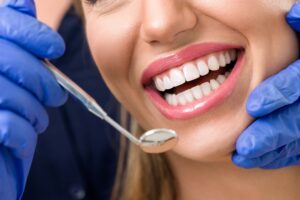
The periodontal tissues in your mouth cover a lot of territory. This soft, pink, absorbent gum tissue is a protective layer to the structures underneath, providing a protective blanket over tooth roots, bone structures, muscles, glands and ligaments.
The health of your gums is vital to the health of your teeth. The gums are designed to snugly wrap the base of each tooth to seal out bacteria and protect the structures that support teeth. Gums that pull away from teeth leave them vulnerable to bacteria that can lead to decay and gum disease.
Just as the skin that covers the outside of our bodies, there can be problems that can affect the gum tissues. And, just as scrapes or rashes on the skin, there are ways to repair problems involving the gum tissues.
As a Shelby Twp dental office, we are committed to helping our patients maintain healthy, pink gums. In addition to advising on thorough, at-home oral care regimens, our dental hygienists provide patients with a boost in this pursuit through 6-month dental check-ups and cleanings.
As a dentist, I believe that knowledge is not only power, it is the best tool in prevention. Below are common problems associated with oral tissues. One of the biggest concerns has to do with receding gums.
Gum recession occurs for various reasons, including:
Poor dental hygiene – When brushing, flossing, and rinsing are insufficient to rid the mouth of bacteria, their accumulation can result in plaque. This is the sticky film you feel on teeth. In just a few days, plaque can harden into tartar. This is a hardened bacterial colony that attaches onto and between teeth. Once formed, brushing or flossing cannot remove tartar. It can only be removed during a professional tooth cleaning. If not removed, teeth, gums and the structures below the gum line can be damaged.
Periodontal (gum) diseases – Caused by bacteria, gum disease destroys oral tissues and the bone that supports natural tooth roots. A sign of periodontal disease is gum recession. In addition to receded gums, periodontal disease may also cause:
• Gum tissues that turn red or purple
• Gums that are tender or swollen
• Gums that bleed when brushing
• Persistent bad breath
Brushing too hard – If you brush your teeth too aggressively or use a hard bristled toothbrush, it can wear away tooth enamel and cause the gums to recede.
Aging – As people age, their gums become drier. This causes them to shrink and be less capable of keeping a secure grip around the base of teeth.
Hormones – During the changes in estrogen levels that females experience (puberty, menstrual periods, pregnancy, menopause), the gums can be more sensitive and vulnerable to gum recession.
Smoking/Vaping – In addition to the many health hazards smokers risk, they are more likely to develop plaque which can lead to gum recession.
Bite misalignment – When teeth don’t come together evenly, too much force can be exerted on the gums and surrounding bone, allowing gums to recede. Bite misalignment can also lead to grinding or clenching teeth. These harsh forces on teeth can cause the gums to loosen their grip.
Noticing that some teeth are getting longer – When the gums recede, sensitivity to hot or cold may occur. Darker segments of the tooth may also be exposed, which are highly vulnerable to oral bacteria. The bacteria of gum disease can damage the structures that support natural teeth. Gum disease is the leading cause of adult tooth loss.
Rather than a wait-&-see position, the goal should always be to repair recession and halt the problem from recurring. To do this, we begin by determining why the gum recession is occurring. The next step is to restore the gums to their proper positions. For this, we use a dental laser.
Because our Nd: YAG Laser seals tissue as it goes, patient comfort is enhanced and healing time is faster. This small, hand-held device is a tremendous asset when it comes to both the health and appearance of gum tissues. Not only does the laser eliminate or greatly minimize bleeding during procedures, it reduces numbing requirements, removes bacteria and easily uncovers gum tissue where dental implants have been placed.
is a tremendous asset when it comes to both the health and appearance of gum tissues. Not only does the laser eliminate or greatly minimize bleeding during procedures, it reduces numbing requirements, removes bacteria and easily uncovers gum tissue where dental implants have been placed.
Additionally, laser dentistry can quickly repair oral ulcers and beautifully re-contour or repair gum tissue with a precision line. Some specific treatments that are ideal for a dental laser include:
Canker & Cold Sores: The laser is also ideal for rapid healing of canker and cold sores. Laser therapy can halt the progression of canker sores, reducing the pain in a day or so. Otherwise, they can last up to 2 weeks. When it comes to cold sores, they are best treated with our laser when the very first symptom arises. Tingling or burning sensation is the first sign that a cold sore is about to erupt. Although lasers can still treat these lesions in later stages, the treatment is most effective in initial stages. Most patients notice significant improvement in comfort after laser treatment with a much shorter duration.
Gum Disease Treatment: In our dental office, we also use a dental laser to destroy the bacteria of gum disease. This technology also speeds the process and heightens your comfort, saving you treatment time with faster healing.
Correcting a “gummy smile”: This is when a smile shows too much gum tissue above upper teeth when smiling fully. We correct this in a procedure known as crown lengthening. In this, a gingivectomy corrects the height of gum tissues so the smile has a more even smile line. This may involve the use of a dental laser, which provides a precision line and speeds healing.
 Balancing a smile line: A gingivectomy is also advised to rebalance the frame of gum tissues that arch the teeth visible in a smile. When one or two teeth have different heights of gum tissue, the smile has a jumbled look. A dental laser can even out the smile line and enhance the beauty of a smile.
Balancing a smile line: A gingivectomy is also advised to rebalance the frame of gum tissues that arch the teeth visible in a smile. When one or two teeth have different heights of gum tissue, the smile has a jumbled look. A dental laser can even out the smile line and enhance the beauty of a smile.
Saving a tooth broken near the gum line: When a tooth breaks at or near the gum line, it often requires removal. In some cases, however, we can save the tooth by exposing enough of the structure to receive a crown. This helps the patient to avoid removal and thereby preserves the supporting jaw bone. The use of a dental laser is the “saving grace” in many of these cases.
Gingivectomies are performed while the patient is comfortably numbed. For some people, sedation may be a preference for enhanced relaxation. Oral sedation is in pill form that allows patients to ‘doze’ through procedures. I.V. sedation, also known as ‘twilight sleep,’ is available for patients who prefer a deeper level of sedation.
Like your “adult” teeth, your gum tissues are irreplaceable and deserve the care and attention they deserve. For any dental need, including gum tissue treatment, smile enhancement, or tooth replacement (including all stages of dental implants), call our Shelby Township dental office: 586-739-2155 or tap here for a free consultation.
If dental fear is an issue that has prevented you from having regular dental care, we offer Oral and I.V. Sedation (“twilight sleep”). Both are administered safely and have a quick recovery.